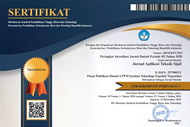Assessing Highrise Building Construction in Semarang Using Green Construction Site Index (GCSI)
Abstract
Keywords
Full Text:
PDFReferences
D. Arditi and K. Mochtar, “Trends in Productivity Improvement in the US Construction Industry,” Journal of Construction Management and economics, vol. 18, 15-27. 2000.
R. A. Begum, J. J. Pereira, C. Siwar, and A. H. Jaafar, “Attitude and behavioral factors in waste management.in construction industry in Malaysia,” Resources, Conservation, and Recycling, 53, 321-328, 2009.
B. A. G. Bossink and H. J. H. Brouwers, H. J. H, “Construction waste: quantification and source evaluation,” Journal of Construction Engineering and Management, Mar. 1996.
W. I. Ervianto, B. W. Soemardi, M. Abduh, and Suryamanto, “Pengembangan Model Assessment Green Construction Pada Proses Konstruksi untuk Proyek Konstruksi di Indonesia,” in Prosiding Konferensi Nasional Pascasarjana Teknik Sipil (KNPTS), Dec. 2011.
S. P. Dozzi and S. M. AbouRizk, “Productivity in Construction,” Institute for Research in Construction. National Research Council, Ottawa, Ontario, Canada, 1993.
J. Ferguson, N. Kermode, C. L. Nash, W. A. J. Sketch, and R. P. Huxford, “Managing and minimizing construction waste: a practical guide,” Thomas Telford Publications, London, 1995.
F. Firmawan, “Karakteristik dan Komposisi Limbah (Construction Waste) pada Pembangunan Proyek Konstruksi,” Makalah Ilmiah Sultan Agung, vol. L, no. 127, p. 27-42, Mei. 2012.
F. Firmawan, et.al. “Improving Project Performance and Waste Reduction in Construction Projects: A Case Study of a Government Institutional Building Project.” International Journal of Technology, 2: 110-120, 2012. ISSN 2086-9614.
F. Firmawan, “Framework for Green Construction Assessment: A Case Study of Government Institution Building Project in Jakarta, Indonesia,” Journal of Emerging Trends in Engineering and Applied Sciences (JETEAS) 3 (4): 576-580 ISSN: 2141-7016, 2012. jeteas.scholarlinkresearch.org.
F. Firmawan, “Environmental Performance Assessment in Construction Projects: A Review,” APSEC-ICCER, Oct. 2012.
Firmawan. et al, “The Green Construction Site Index (GCSI): A Quantitative Tool Used to Assess an Ongoing Project To Meet The Green Construction Concept,” International Journal of Technology, vol. 7 no. 4, p.530-543 ISSN: 2086-9614, Apr. 2016.
B. Fishbein, “Building for Future : Strategies to reduce construction and demolition waste in municipal projects,” Retrieved 1998. From www.informinc.org/cdreport.html.
M. Gangolells, A. Casals, S. Gasso, N. Forcada, X. Roca, A. Fuertes, “A Methodology for Predicting The Severity Of Environmental Impacts Related To The Construction Process Of Residential Buildings,” Building and Environment, 44, 558– 571, 2009.
H. Arslan, N. Cosgun, and B. Salgin, Construction and Demolition Waste Management in Turkey, Waste Management - An Integrated Vision, Dr. Luis Fernando Marmolejo Rebellon (Ed.), InTech, 2012. ISBN: 978-953-51-0795-8, DOI: 10.5772/46110. Available from: http://www.intechopen.com/books/waste-management-an-integrated-vision/construction-and-demolition-waste-management-inturkey.
J. H. Kim, J. M. Kim, H. S. Cha, and D. W. Shin, “Development of the Construction Waste Management Performance Evaluation Tool,” ISARC, 2006.
Lau et al, “Composition and Characteristics of Construction Waste Generated by Residential Housing Project,” Int. J. Environ. Res., 2 (3): 261-268 ISSN: 1735-6865, Summer, 2008.
X. Li, Y. Zhu, and Z. Zhang, “An LCA-based environmental impact assessment model for construction processes,” Building and Environment, vol. 45, p 766–775, 2009.
M. A Abdurrahman, R. U. Latief, A. S. Mustari, and L. Mustika. “Green construction application of the vida view apartment project in Makassar,” IOP Conf. Series: Earth and Environmental Science, 419, 2020.
A. F. Masudi, C. R. Che Hassan, N. Z. Mahmood, S. N. Mokhtar, and N. M. Sulaiman, “Construction Waste Quantification and Benchmarking: A Study in Klang Valley, Malaysia,” Journal of Chemistry and Chemical Engineering, vol. 5, no.10, p. 909-916, Oct. 2011.
T. H. Mills, E. Showalter and D. Jarman, “A Cost-Effective Waste Management Plan,” Cost Engineering, 41 (3): 35–43, 1999.
V. Nitivattananon and G. Borongan, “Construction and Demolition Waste Management: Current Practices in Asia,” Proceedings of the International Conference on Sustainable Solid Waste Management, 5 - 7 Sep. 2007, Chennai, India. p. 97-104.
G. Ofori and L. L Ekanayake, “Construction Material Waste Source Evaluation,” Proceedings: Strategies for a Sustainable Built Environment, Pretoria, 23-25, Aug. 2000.
G. Ofori and L. L. Ekanayake, “Building Waste Assessment Score: Design-Based Tool,” Building and Environment, 39, 2004, 851-861.
C. S. Poon, A. T. W. Yu, and L. H. Ng, “On-site sorting of C&D waste in Hong Kong,” Resources, Conservation and Recycling, 32, 2001, 157-172.
Productivity Alberta, 2008. http://www.albertacanada.com/productivity/about
M. J. Rogoff and J. F. Williams, Approaches to Implementing Solid Waste Recycling Facilities, Noyes, Park Ridge, NJ, 1994.
S. Chockalingam and T. Sornakumar, “An Efficient Electrical Safety Performance Tool for Indian Construction Industry-ESA Approach,” International Journal of Electrical Engineering, vol. 4, p. 399-414, 2011.
B. J. Sealey, P. S. Phillips, and G. J. Hill, “Waste Management Issues for the UK Ready mixed Concrete Industry,” Resources, Conservation and Recycling, 32 (3–4): 321–331, 2001.
L. Y. Shen, W. S. Lu, H. Yao, and D. H. Wu, “A computer-based scoring method for measuring the environmental performance of construction activities,” Automation in Construction, 14, 2005, 297– 309.
I. S. Siagian, Bahan Bangunan yang Ramah Lingkungan, Universitas Sumatera Utara, 2005.
H. Suprapto and S. Wulandari, “Studi Model Pengelolaan Limbah Konstruksi Dalam Pelaksanaan Pembangunan Proyek Konstruksi,” Proceeding PESAT (Psikologi, Ekonomi, Sastra, Arsitektur&Sipil), vol. 3, Universitas Gunadarma, Depok, 20-21 Oct. 2009.
V. W. Y. Tam and K. N. Le, “Assessing Environmental Performance in the Construction Industry,” Surveying and Built Environment, vol. 18 (2), 59-72, 2007.
K. Yahya and A. H. Boussabaine, “Eco-costing of Construction Waste,” International Journal of Environmental Quality Management, vol. 17, no.1, p. 6 – 19, 2006.
DOI: http://dx.doi.org/10.12962%2Fj2579-891X.v20i1.11291
Refbacks
- There are currently no refbacks.

Jurnal Aplikasi Teknik Sipil by Pusat Publikasi Ilmiah LPPM Institut Teknologi Sepuluh Nopember is licensed under a Creative Commons Attribution-ShareAlike 4.0 International License
Based on work at https://iptek.its.ac.id/index.php/jats




